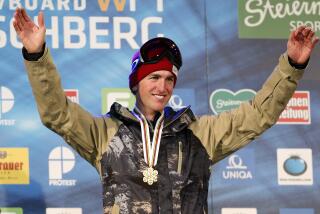Leaping Into the Lead : American Ski Maker K2 Ices Europeans
SEATTLE — “Aaahhhhh, I’m a mass of atoms,” screams extreme skier Glen Plake, star of K2’s latest television spot. As Plake hurls into the air, his 17-inch Mohawk slices through flying snow, and an atom bomb produces a mushroom cloud.
Back at the K2 factory, located on Vashon Island in Puget Sound, K2 Vice President Jim Bennett studies a series of charts that plot the dramatic improvements in efficiency and product quality the company has achieved in recent years.
Brash, all-American marketing combined with efficient, Japanese-style manufacturing: That’s the formula K2, the only remaining major American ski manufacturer, has used to strike back at its powerful European competitors.
Boosted by some of the best snow conditions California has seen in years, the ski equipment industry is enjoying a record season, and K2 has been the biggest beneficiary. For the month of November, K2, which also sells Olin and PRE skis, overtook world leader Rossignol in the U.S. market for the first time in three years, according to an audit of retail stores by Boulder, Colo.-based Recreation Research, a market research firm.
“We’ve paid a huge cost,” Richard M. Rodstein, president of Anthony Industries, the Los Angeles-based parent of K2, said in describing a recent factory overhaul and the new marketing campaign launched last fall. But the investment is now paying off.
“A couple of years ago they were lagging behind,” said Ed Pitoniak, editor in chief of Ski magazine, which does extensive ski equipment testing. “Now they’re getting gold medals in every category.” K2 surprised the industry with a highly successful midseason introduction of a ski it calls the Missile, and it garnered 25% of the domestic ski market in November, up from 20% last year. Rossignol’s share has slumped to 23% from 25% the year before.
“We consider Anthony an undiscovered story,” said Tim Conder, an analyst at A.G. Edwards & Sons, a New York securities firm that has put a strong “buy” recommendation on the stock. Anthony makes the bulk of its $500 million a year in revenue selling such prosaic items as fishing poles, decorative fiberglass lampposts and pool covers, but Conder sees its success in skis as indicative of broader competence. “They are well-managed, they put the right people in the right place,” he said.
K2’s resurgence is a marketing triumph for Tim Petrick, a professional skier who became general manager of K2’s North American operations two years ago. “He revived the raw energy and edginess that used to prevail before the industry got MBA-ized,” Pitoniak said. “He came as a skier, not as a suit.”
Explains Petrick: “This is a little ski company trying to fight against big European companies. We don’t want to be subtle.”
Subtle it is not. One advertisement, showing a skier on K2s heading down a cliff, challenges: “The only excuse you have left is that yellow stripe running down your back.”
“It’s like trash-talking on the basketball court,” said Tracy Wong, creative director at WongDoody, the small Seattle ad agency that designed the campaign. “It fires you up.”
It’s also a distinctly American message for a company whose American-ness has been built into its corporate image. K2’s corporate colors are red, white and blue, and the USA graphics are built into every ski design.
“There is increasing awareness that an American manufacturing base is important,” Petrick said. He said Americans are beginning to consider nationality when they buy skis, the same way European and Japanese buyers long have. “Austrians use Austrian skis, the French buy French and the Germans ski German skis,” he said.
Selling America, however, means manufacturing in America. K2’s ability to remain a cost-competitive producer--despite the logistics of being on an island where 60% of its work force has to commute by ferry--has been a key ingredient of its success.
K2 was founded in 1962 by Bill and Don Kirschner, two brothers who had been making animal cages out of fiberglass when they decided to build a pair of skis for their own use. The ski they designed, which had a spruce core wrapped in braided fiberglass cord, has since been imitated by ski makers around the world. Beginning production with $5,000 of equipment purchased from a bankrupt California firm, K2 by 1968 could already boast a World Cup gold medalist who had skied to fame on its skis.
But the company was caught behind the curve when European competitors swept the industry with the “cap” ski, initially introduced in 1990. While there were--and still are--fierce debates as to whether or not the plastic cap that covers the top and sides of the ski makes for better carving ability, nobody could argue with the enthusiasm with which consumers were taken by the sleek new European design.
Early this year, Anthony Industries finally gave in to the trend. It transferred one of its top production managers, Jim Bennett, from a lamppost factory in South Carolina to Vashon Island to retool the K2 factory. Starting virtually from scratch, the company’s machine shop designed, built and installed a new production line. “From concept to manufacturing was three months,” Bennett said.
K2’s quality initially plunged with the increased complexity of the new process. Bennett taught statistical quality control methods so workers could learn to spot errors and find ways to eliminate them. One of his finds: Tim Furgeson, a high school graduate with an almost instinctual knack for finding solutions. “I’ll stack him up against any manufacturing engineer,” Bennett said. “I call him my Forrest Gump.”
Asked to look at a problem with breakage in the wooden cores used in the skis, Furgeson designed a cart with steel bars to keep the boards neatly stacked. To test it, he stacked it with wooden cores and pulled it over speed bumps in the parking lot. The cart worked, saving the company $350,000 a year in material costs.
Another problem: dimples that marred the surface of the skis. A Japanese statistical approach called the Taguchi method was used to home in on the problem and design a process to solve it. The result not only got rid of the dimples but boosted productivity 30%.
The reject rate was 30% when the factory first converted earlier this year. Today it is down to 4%--below the rate of the earlier, simpler technology--and still falling.
Still, a company can be only so successful with skis alone. U.S. ski sales are healthy, but worldwide they have been in steady decline, totaling just 5.2 million pairs last season, down from 6.3 million five years ago.
For Anthony Industries, that means it’s time to cash in on the K2 brand in other areas. The company has launched successful products in new categories such as in-line skates and snowboards.
“We want to have 50% of sales come from new products,” Rodstein said. The in-line skates, which boast a newly designed soft shoe, are expected to bring in more than $10 million in sales in their first year on the market.
Snowboarding is another sleeper. Sales were poor when the boards were sold as part of the company’s ski line in the early 1990s. Two years ago, K2 created a separate snowboard division led by young boarders doing their own design and marketing.
Snowboarding has to be handled separately, said ad exec Wong, because boarders have a different attitude. “It’s young counterculture. Anything that pisses off baby boomers or parents. Its aggressive, male-testosterone driven.”
Since the independent division was established, snowboard sales have quintupled to $10 million. Such successes are expected to help Anthony bring in $104 million on K2-brand products this year, up 35% from 1992.
The company has also made acquisitions in areas such as mountain bikes and outdoor gear, markets that are growing rich on aging baby boomers willing to spend large sums on outdoor activities.
“Our name is magic,” Rodstein said. “It has a great name and its a great company. We’re going to add lots of product.”
(BEGIN TEXT OF INFOBOX / INFOGRAPHIC)
King of the Mountain
Anthony Industries subsidiary K2, the only major American ski manufacturer, has combined flashy marketing and solid manufacturing to overtake its European rivals in U.S. sales.
Anthony Industries at a Glance
Headquarters: Los Angeles
Chief Executive: Bernard I. Forester
President: Richard M. Rodstein
Employees: 3,700
Products: Snow skis, fishing tackle, swimming pools, mountain bicycles, in-line skates, snowboards
1993 revenue: $431.6 million
1993 profit: $11.1 million
Earnings per share: $0.94
Dec. 30 stock price: $16, down 62.5 cents on the New York Stock Exchange
Market Share
1994 market share of ski brands, based on U.S. specialty store sales through November:
K2: 23%
Rossignol: 21%
Salomon: 19%
Elan: 9%
Dynastar: 6%
Other: 22%
K2’s Rise
K2 market share over the past six years:
1994*: 23%
* Through November
Sources: Recreation Research, A.G. Edwards; Bloomberg Business News
Researched by ADAM S. BAUMAN / Los Angeles Times
More to Read
Inside the business of entertainment
The Wide Shot brings you news, analysis and insights on everything from streaming wars to production — and what it all means for the future.
You may occasionally receive promotional content from the Los Angeles Times.










